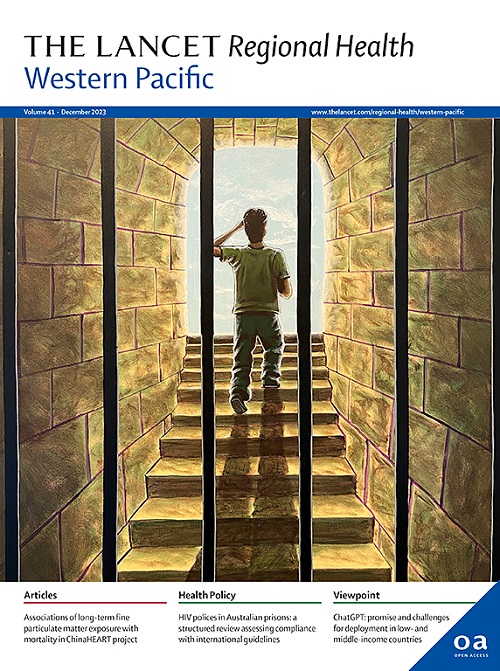利用国际围产期死亡率疾病分类(ICD-PM)和死因推断来确定柬埔寨农村死产和新生儿死亡的原因:一项基于人群的前瞻性队列研究
IF 8.1
1区 医学
Q1 HEALTH CARE SCIENCES & SERVICES
引用次数: 0
摘要
背景围产期死亡率仍然是一个重大的全球健康挑战,特别是在低收入和中等收入国家。准确的死因数据对于告知有效的干预措施至关重要,但往往很少。本研究旨在利用尸检(VA)和世卫组织围产期死亡疾病国际分类(ICD-PM)确定柬埔寨农村死产和新生儿死亡的原因。方法在柬埔寨柏威夏省开展了一项为期4年(2018-2022)的前瞻性研究,建立了以社区卫生工作者为基础的妊娠监测系统。对死产和新生儿死亡进行了尸检,并通过双医生分析来解释VA数据。为了对死亡原因进行分类,应用了ICD-PM,并对死亡时间未知的死产进行了调整。结果共记录了522例死亡(229例死产,293例新生儿死亡),79.1%(413例)有VA。应用ICD-PM,确定了36.6%的死产和95.0%的新生儿死亡的主要死亡原因。死亡的主要原因是产时死产缺氧(78.3%),早期新生儿死亡低出生体重和早产(40.9%),晚期新生儿死亡感染(51.4%)。分娩和分娩期间的并发症是产妇导致产时死产(63.3%)和新生儿早期死亡(42.4%)的主要原因。死亡时间不明的死产占12.0%。ICD-PM与va数据的应用为死产和新生儿死亡的原因提供了有价值的见解。然而,适应是必要的,以解决ICD-PM的局限性,特别是对未知死亡时间进行分类。我们的研究结果有助于全球努力改善围产期死亡率数据的报告。本研究嵌在拯救婴儿生命研究中,该研究得到了吴哥儿童医院、民间社会发展、傅德安基金会、Manan信托、T&;J Meyer家庭基金会、Vitol基金会、IF基金会和惠康信托基金的资助[220211]。本研究部分由惠康基金会资助[220211/Z/20/Z]。本文章由计算机程序翻译,如有差异,请以英文原文为准。
Use of the International Classification of Diseases to Perinatal Mortality (ICD-PM) with verbal autopsy to determine the causes of stillbirths and neonatal deaths in rural Cambodia: a population-based, prospective, cohort study
Background
Perinatal mortality remains a significant global health challenge, particularly in low- and middle-income countries (LMICs). Accurate cause-of-death data are essential to inform effective interventions but are often scarce. This study aimed to identify causes of stillbirths and neonatal deaths in rural Cambodia using verbal autopsy (VA) and the WHO International Classification of Diseases to Perinatal Mortality (ICD-PM).
Methods
A four-year prospective study (2018–2022) in Preah Vihear province, Cambodia, established a community health worker-based pregnancy surveillance system. Verbal autopsy was conducted on stillbirths and neonatal deaths, with dual physician analysis to interpret VA data. To classify causes of death, ICD-PM was applied with adaptations made for stillbirths with unknown timing of death.
Findings
A total of 522 deaths (229 stillbirths, 293 neonatal deaths) were recorded, and 79.1% (413) had a VA. Applying ICD-PM, primary causes of death were identified for 36.6% of stillbirths and 95.0% of neonatal deaths. The leading cause of death was hypoxia for intrapartum stillbirths (78.3%), low birth weight and prematurity for early neonatal deaths (40.9%), and infection for late neonatal deaths (51.4%). Complications during labour and delivery were the leading maternal contributing condition for intrapartum stillbirths (63.3%) and early neonatal deaths (42.4%). Unknown timing of death was assigned to 12.0% of stillbirths.
Interpretation
Application of ICD-PM with VA-derived data provides valuable insights into causes of stillbirths and neonatal deaths. However, adaptations are necessary to address ICD-PM's limitations, particularly to classify unknown timing of death. Our findings can contribute to global efforts to improve the reporting of perinatal mortality data.
Funding
This study is nested in the Saving Babies' Lives study, which was supported by funding from Angkor Hospital for Children, Civil Society in Development, Fu Tak Iam Foundation, Manan Trust, T&J Meyer Family Foundation, Vitol Foundation, IF Foundation, and Wellcome Trust [220211]. This research was funded in part by the Wellcome Trust [220211/Z/20/Z].
求助全文
通过发布文献求助,成功后即可免费获取论文全文。
去求助
来源期刊

The Lancet Regional Health: Western Pacific
Medicine-Pediatrics, Perinatology and Child Health
CiteScore
8.80
自引率
2.80%
发文量
305
审稿时长
11 weeks
期刊介绍:
The Lancet Regional Health – Western Pacific, a gold open access journal, is an integral part of The Lancet's global initiative advocating for healthcare quality and access worldwide. It aims to advance clinical practice and health policy in the Western Pacific region, contributing to enhanced health outcomes. The journal publishes high-quality original research shedding light on clinical practice and health policy in the region. It also includes reviews, commentaries, and opinion pieces covering diverse regional health topics, such as infectious diseases, non-communicable diseases, child and adolescent health, maternal and reproductive health, aging health, mental health, the health workforce and systems, and health policy.
 求助内容:
求助内容: 应助结果提醒方式:
应助结果提醒方式:


